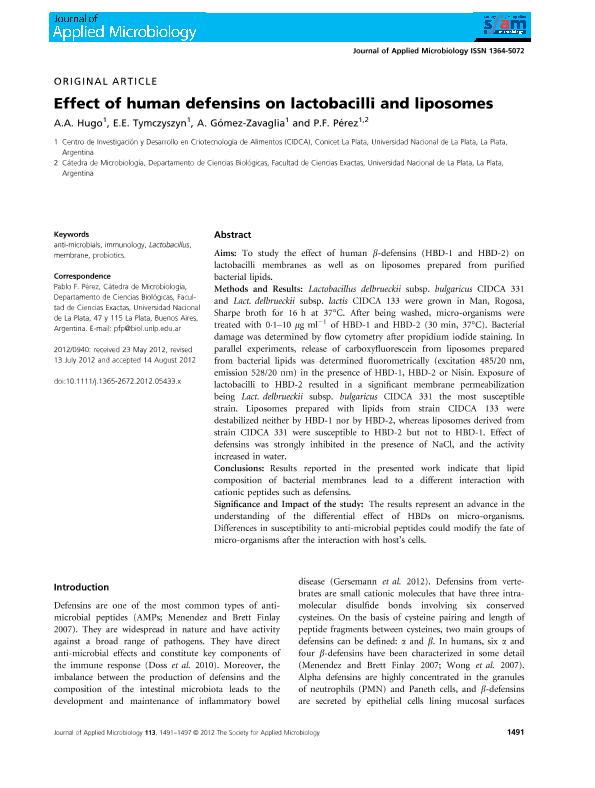Mostrar el registro sencillo del ítem
dc.contributor.author
Hugo, Ayelen Amelia

dc.contributor.author
Tymczyszyn, Emma Elizabeth

dc.contributor.author
Gomez Zavaglia, Andrea

dc.contributor.author
Perez, Pablo Fernando

dc.date.available
2020-04-24T19:42:54Z
dc.date.issued
2012-11
dc.identifier.citation
Hugo, Ayelen Amelia; Tymczyszyn, Emma Elizabeth; Gomez Zavaglia, Andrea; Perez, Pablo Fernando; Effect of human defensins on lactobacilli and liposomes; Wiley Blackwell Publishing, Inc; Journal of Applied Microbiology; 113; 11-2012; 1491-1497
dc.identifier.issn
1364-5072
dc.identifier.uri
http://hdl.handle.net/11336/103585
dc.description.abstract
Aims: To study the effect of human b-defensins (HBD-1 and HBD-2) on lactobacilli membranes as well as on liposomes prepared from purified bacterial lipids. Methods and Results: Lactobacillus delbrueckii subsp. bulgaricus CIDCA 331 and Lact. delbrueckii subsp. lactis CIDCA 133 were grown in Man, Rogosa, Sharpe broth for 16 h at 37°C. After being washed, micro-organisms were treated with 0 1–10 lg ml1 of HBD-1 and HBD-2 (30 min, 37°C). Bacterial damage was determined by flow cytometry after propidium iodide staining. In parallel experiments, release of carboxyfluorescein from liposomes prepared from bacterial lipids was determined fluorometrically (excitation 485/20 nm, emission 528/20 nm) in the presence of HBD-1, HBD-2 or Nisin. Exposure of lactobacilli to HBD-2 resulted in a significant membrane permeabilization being Lact. delbrueckii subsp. bulgaricus CIDCA 331 the most susceptible strain. Liposomes prepared with lipids from strain CIDCA 133 were destabilized neither by HBD-1 nor by HBD-2, whereas liposomes derived from strain CIDCA 331 were susceptible to HBD-2 but not to HBD-1. Effect of defensins was strongly inhibited in the presence of NaCl, and the activity increased in water. Conclusions: Results reported in the presented work indicate that lipid composition of bacterial membranes lead to a different interaction with cationic peptides such as defensins. Significance and Impact of the study: The results represent an advance in the understanding of the differential effect of HBDs on micro-organisms. Differences in susceptibility to anti-microbial peptides could modify the fate of micro-organisms after the interaction with host’s cells.
dc.format
application/pdf
dc.language.iso
eng
dc.publisher
Wiley Blackwell Publishing, Inc

dc.rights
info:eu-repo/semantics/openAccess
dc.rights.uri
https://creativecommons.org/licenses/by-nc-sa/2.5/ar/
dc.subject
ANTIMICROBIALS
dc.subject
IMMUNOLOGY
dc.subject
LACTOBACILLUS
dc.subject
MEMBRANE
dc.subject
PROBIOTICS
dc.subject.classification
Alimentos y Bebidas

dc.subject.classification
Otras Ingenierías y Tecnologías

dc.subject.classification
INGENIERÍAS Y TECNOLOGÍAS

dc.title
Effect of human defensins on lactobacilli and liposomes
dc.type
info:eu-repo/semantics/article
dc.type
info:ar-repo/semantics/artículo
dc.type
info:eu-repo/semantics/publishedVersion
dc.date.updated
2020-04-22T15:33:07Z
dc.journal.volume
113
dc.journal.pagination
1491-1497
dc.journal.pais
Reino Unido

dc.journal.ciudad
Londres
dc.description.fil
Fil: Hugo, Ayelen Amelia. Provincia de Buenos Aires. Gobernación. Comisión de Investigaciones Científicas. Centro de Investigación y Desarrollo en Criotecnología de Alimentos. Consejo Nacional de Investigaciones Científicas y Técnicas. Centro Científico Tecnológico Conicet - La Plata. Centro de Investigación y Desarrollo en Criotecnología de Alimentos. Universidad Nacional de la Plata. Facultad de Ciencias Exactas. Centro de Investigación y Desarrollo en Criotecnología de Alimentos; Argentina
dc.description.fil
Fil: Tymczyszyn, Emma Elizabeth. Provincia de Buenos Aires. Gobernación. Comisión de Investigaciones Científicas. Centro de Investigación y Desarrollo en Criotecnología de Alimentos. Consejo Nacional de Investigaciones Científicas y Técnicas. Centro Científico Tecnológico Conicet - La Plata. Centro de Investigación y Desarrollo en Criotecnología de Alimentos. Universidad Nacional de la Plata. Facultad de Ciencias Exactas. Centro de Investigación y Desarrollo en Criotecnología de Alimentos; Argentina
dc.description.fil
Fil: Gomez Zavaglia, Andrea. Provincia de Buenos Aires. Gobernación. Comisión de Investigaciones Científicas. Centro de Investigación y Desarrollo en Criotecnología de Alimentos. Consejo Nacional de Investigaciones Científicas y Técnicas. Centro Científico Tecnológico Conicet - La Plata. Centro de Investigación y Desarrollo en Criotecnología de Alimentos. Universidad Nacional de la Plata. Facultad de Ciencias Exactas. Centro de Investigación y Desarrollo en Criotecnología de Alimentos; Argentina
dc.description.fil
Fil: Perez, Pablo Fernando. Provincia de Buenos Aires. Gobernación. Comisión de Investigaciones Científicas. Centro de Investigación y Desarrollo en Criotecnología de Alimentos. Consejo Nacional de Investigaciones Científicas y Técnicas. Centro Científico Tecnológico Conicet - La Plata. Centro de Investigación y Desarrollo en Criotecnología de Alimentos. Universidad Nacional de la Plata. Facultad de Ciencias Exactas. Centro de Investigación y Desarrollo en Criotecnología de Alimentos; Argentina. Universidad Nacional de La Plata. Facultad de Ciencias Exactas. Departamento de Ciencias Biológicas. Cátedra de Microbiología General; Argentina
dc.journal.title
Journal of Applied Microbiology

dc.relation.alternativeid
info:eu-repo/semantics/altIdentifier/doi/http://dx.doi.org/10.1111/j.1365-2672.2012.05433.x
dc.relation.alternativeid
info:eu-repo/semantics/altIdentifier/url/https://sfamjournals.onlinelibrary.wiley.com/doi/full/10.1111/j.1365-2672.2012.05433.x
Archivos asociados
